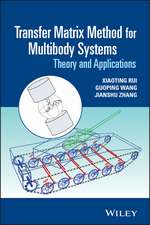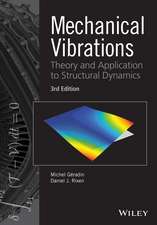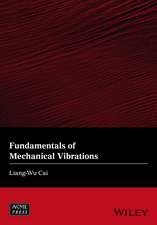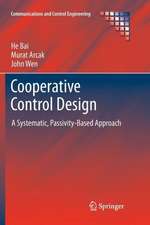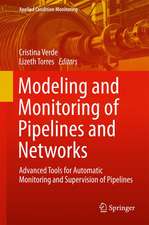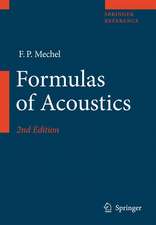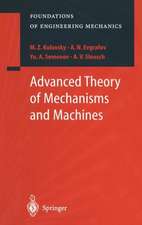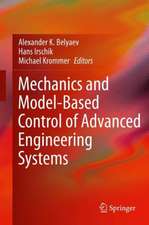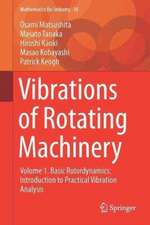Handbook of Signal Processing in Acoustics
Editat de David Havelock, Sonoko Kuwano, Michael Vorländeren Limba Engleză Paperback – 22 aug 2016
| Toate formatele și edițiile | Preț | Express |
|---|---|---|
| Paperback (1) | 3713.57 lei 38-44 zile | |
| Springer – 22 aug 2016 | 3713.57 lei 38-44 zile | |
| Hardback (1) | 4257.41 lei 22-36 zile | |
| Springer – 21 ian 2009 | 4257.41 lei 22-36 zile |
Preț: 3713.57 lei
Preț vechi: 4886.27 lei
-24% Nou
Puncte Express: 5570
Preț estimativ în valută:
710.82€ • 772.36$ • 597.47£
710.82€ • 772.36$ • 597.47£
Carte tipărită la comandă
Livrare economică 16-22 aprilie
Preluare comenzi: 021 569.72.76
Specificații
ISBN-13: 9781493938391
ISBN-10: 1493938398
Pagini: 1950
Ilustrații: L, 1950 p. In 2 volumes, not available separately.
Dimensiuni: 178 x 235 mm
Ediția:Softcover reprint of the original 1st ed. 2008
Editura: Springer
Colecția Springer
Locul publicării:New York, NY, United States
ISBN-10: 1493938398
Pagini: 1950
Ilustrații: L, 1950 p. In 2 volumes, not available separately.
Dimensiuni: 178 x 235 mm
Ediția:Softcover reprint of the original 1st ed. 2008
Editura: Springer
Colecția Springer
Locul publicării:New York, NY, United States
Cuprins
Acoustic Signals and Systems.- Signals and Systems.- Acoustic Data Acquisition.- Spectral Analysis and Correlation.- The FFT and Tone Identification.- Measuring Transfer-Functions and Impulse Responses.- Digital Sequences.- Filters.- Adaptive Processing.- Beamforming and Wavenumber Processing.- Auditory System and Hearing.- Anatomy, Physiology and Function of the Auditory System.- Physiological Measures of Auditory Function.- Auditory Processing Models.- Speech Intelligibility.- Signal Processing in Hearing Aids.- Psychoacoustics.- Methods for Psychoacoustics in Relation to Long-Term Sounds.- Masking and Critical Bands.- Aspects of Modeling Pitch Perception.- Calculation of Loudness for Normal and Hearing-Impaired Listeners.- Psychoacoustical Roughness.- Musical Acoustics.- Automatic Music Transcription.- Music Structure Analysis from Acoustic Signals.- Computer Music Synthesis and Composition.- Singing Voice Analysis, Synthesis, and Modeling.- Instrument Modeling and Synthesis.- Digital Waveguide Architectures for Virtual Musical Instruments.- Modeling of Musical Instruments.- Speech.- Display and Analysis of~Speech.- Estimation of Speech Intelligibility and Quality.- Gaussian Models in Automatic Speech Recognition.- Speech Synthesis.- Speech Coders.- Audio Engineering.- Transducer Models.- Loudspeaker Design and Performance Evaluation.- PA Systems for Indoor and Outdoor.- Beamforming for Speech and Audio Signals.- Digital Audio Recording Formats and Editing Principles.- Audiovisual Interaction.- Multichannel Sound Reproduction.- Virtual Acoustics.- Audio Restoration.- Audio Effects Generation.- Perceptually Based Audio Coding.- Telecommunications.- Speech Communication and Telephone Networks.- Methods of Determining the Communicational Quality of Speech Transmission Systems.- Efficient Speech Coding and Transmission Over Noisy Channels.- Echo Cancellation.- Noise Reduction and Interference Cancellation.- Terminals and Their Influence on Communication Quality.- Networks and Their Influence on Communication Quality.- Interaction of Terminals, Networks and Network Configurations.- Noise.- Sound Levels of Noise Sources.- Outdoor Measurements.- Measurements of Physical Characteristics Using Sound at Audible or Lower Frequencies.- Community Response to Noise.- Active Noise Control.- Forward Control in Single-Channel Systems.- Forward Control in Multichannel Systems.- Feedback Control Systems.- Structural Acoustics and Vibration.- Intensity Techniques.- Nearfield Acoustical Holography.- Actuator Design and Deployment.- Materials Testing.- Bioresponse to Vibration.- Tactile Responses to Vibration.- Uses and Applications of Somatosensation.- Sensory Substitution.- Transducers for Acoustic Measurement.- Condenser Microphones.- Dynamic Pressure Microphones.- Dynamic Pressure Difference Microphones.- The Microflown Particle Velocity Sensor.- Microphone Calibration.- Piezoceramic Accelerometer.- Laser Doppler Velocimeter.- Capacitive Sensors.- Engineering Acoustics.- Energy Saving Transducers and Thermoacoustics.- Sinusoidal Representation of Acoustic Signals.- Room Transfer Function.- Spatial Information of Sound Fields.- Infrasonics.- Infrasound Event Detection Using the Progressive Multi-Channel Correlation Algorithm.- Ray Tracing in an Inhomogeneous Atmosphere with Winds.- Infrasonic Data Processing at the Provisional Technical Secretariat of the Comprehensive Nuclear-Test-Ban Organization.- The Design and Performance of Infrasound Noise-Reducing Pipe Arrays.- Processing Infrasonic Array Data.- Infrasound Propagation.- Seismology.- Structureand Elastic Properties of the Earth.- Seismic Wave Propagation.- Seismic Data Acquisition.- Signal Models in Seismic Processing.- Deconvolution and Optimal Filtering in Seismology.- Seismic Migration Imaging.- Geophysical Parameter Estimation.- Earthquake Localization.- Seismic Tomography.- Array Signal Processing.- Underwater and Oceanographic Acoustics.- Propagation and Signal Modeling.- Statistical Signal Processing.- Inverse Problems in Underwater Acoustics.- Active Sonar.- Passive Sonar.- Transducers for Sonar Systems.- Flow Noise.- Animal Bioacoustics.- Bat Bioacoustics.- Fish Bioacoustics.- Amphibian Bioacoustics.- Avian Bioacoustics.- Cetacean Bioacoustics with Emphasis on Recording and Monitoring.
Recenzii
From the reviews:
“The ‘Handbook of Signal Processing in Acoustics’ provides an excellent reference for practicing acousticians and engineers. … encompasses essential background material, technical details, standards, and practical tips. It is aimed to a public with some knowledge of signal processing, and it is meant to be used as a reference. … Signal processing techniques which find major application in different areas of acoustics are well presented from different perspectives … . this compendium is an excellent reference for engineers and professionals working in acoustics.” (Joaquin E. Moran, Noise Control Engineering Journal, Vol. 58 (6), November-December, 2010)
“The ‘Handbook of Signal Processing in Acoustics’ provides an excellent reference for practicing acousticians and engineers. … encompasses essential background material, technical details, standards, and practical tips. It is aimed to a public with some knowledge of signal processing, and it is meant to be used as a reference. … Signal processing techniques which find major application in different areas of acoustics are well presented from different perspectives … . this compendium is an excellent reference for engineers and professionals working in acoustics.” (Joaquin E. Moran, Noise Control Engineering Journal, Vol. 58 (6), November-December, 2010)
Notă biografică
David Havelock studied Mathematics and Physics as an undergraduate at Carleton University and obtained his M.Sc in Mathematics at the University of Bristish Columbia. After a period of employment in the areas of seismology and then submarine detection, he joined the Division of Physics at the National Research Council and completed his Ph.D. in Systems Engineering at Carleton University. While there, he has worked in Photogrammetric, Computer Imaging, and (since 1989) Acoustics. While in the Acoustics and Signal Processing Group of the Institute for Microstructural Sciences at the NRC, his main areas of research have been microphone arrays and outdoor sound propagation. He is a fellow of the ASA, past Chair and founding member of its Technical Committee on Signal Processing in Acoustics and was Technical Program Chair for the joint ASA, EAA, DEGA meeting in Berlin, 1999. He is married and has two wonderful daughters.
Sonoko Kuwano was born on 19 December 1944 in Japan. She is a Professor of the Laboratory of Environmental Psychology, Graduate School of Human Sciences, Osaka University. She is also a Professor of the Department of Environmental Engineering, Graduate School of Engineering, Osaka University. She graduated from Osaka University with a B.A. degree in Psychology in 1967, and received a Ph.D. in Engineering in 1983 from the University of Tokyo. Her interests are psychological evaluation of environmental noise, cross-cultural study of noise problems, evaluation of sound quality of machinery noise and perception of non-steady state sounds. She was a guest researcher of the Institute of Electroacoustics (Institute of Man-Machine Communication) at the Technical University of Munich in 1985, 1988, 1990, 1993, 1995 and 1997. She is a member of Board of International Commission for Acoustics and a fellow of the Acoustical Society of America. She was the President of the Acoustical Society of Japan (ASJ), the Vice-President of INCE/Japan and the President of Japanese Society for Music Perception and Cognition. She was a co-editor of Handbook of Ergonomics published in 2003, a member of the editorial board of Dictionary of Acoustics edited by ASJ and the editor of the proceedings of many international congresses such as Inter-noise 94 and the third ASA and ASJ Joint Meeting. She has been a member of many committees on environmental problems in central or local governments in Japan, such as the Ministry of the Environment, the Ministry of Land, Infrastructure and Transport, Osaka Prefecture, etc. She won a Sato Paper Prize of ASJ in 1983 and 1987.
Michael Vorländer is Professor at RWTH Aachen University, Germany. After university education in physics and doctor degree (Aachen, 1989 with a thesis in room acoustical computer simulation) he worked in various fields of acoustics at the PTB Braunschweig, the National Laboratory for Physics and Technology. First research activities were focused on psychoacoustics and electroacoustics. In 1991 he became head of the PTB laboratory of room and building acoustics. In 1995 he finished the qualification as university lecturer (habilitation) with a thesis on reciprocity calibration of microphones in reverberation chambers. In 1996 he accepted an offer from RWTH Aachen University for a chair and Director of the Institute of Technical Acoustics. Michael Vorländer is member of the German Acoustical Society, DEGA, of the German Physical Society, DPG, and fellow of the Acoustical Society of America, ASA. He is actively involved in the European Acoustics Association, EAA, as President of the term 2004 – 2007 and Vice-President in the term 2007-2010. Also he served in several positions as conference chairs such as the General Co-chair of Acoustics08, the 2nd joint meeting of ASA and EAA in Paris. His main interests are virtual acoustics (auralization), architectural acoustics, binaural technology and acoustic measurements. Michael Vorländer is marriedand has three sons.
Sonoko Kuwano was born on 19 December 1944 in Japan. She is a Professor of the Laboratory of Environmental Psychology, Graduate School of Human Sciences, Osaka University. She is also a Professor of the Department of Environmental Engineering, Graduate School of Engineering, Osaka University. She graduated from Osaka University with a B.A. degree in Psychology in 1967, and received a Ph.D. in Engineering in 1983 from the University of Tokyo. Her interests are psychological evaluation of environmental noise, cross-cultural study of noise problems, evaluation of sound quality of machinery noise and perception of non-steady state sounds. She was a guest researcher of the Institute of Electroacoustics (Institute of Man-Machine Communication) at the Technical University of Munich in 1985, 1988, 1990, 1993, 1995 and 1997. She is a member of Board of International Commission for Acoustics and a fellow of the Acoustical Society of America. She was the President of the Acoustical Society of Japan (ASJ), the Vice-President of INCE/Japan and the President of Japanese Society for Music Perception and Cognition. She was a co-editor of Handbook of Ergonomics published in 2003, a member of the editorial board of Dictionary of Acoustics edited by ASJ and the editor of the proceedings of many international congresses such as Inter-noise 94 and the third ASA and ASJ Joint Meeting. She has been a member of many committees on environmental problems in central or local governments in Japan, such as the Ministry of the Environment, the Ministry of Land, Infrastructure and Transport, Osaka Prefecture, etc. She won a Sato Paper Prize of ASJ in 1983 and 1987.
Michael Vorländer is Professor at RWTH Aachen University, Germany. After university education in physics and doctor degree (Aachen, 1989 with a thesis in room acoustical computer simulation) he worked in various fields of acoustics at the PTB Braunschweig, the National Laboratory for Physics and Technology. First research activities were focused on psychoacoustics and electroacoustics. In 1991 he became head of the PTB laboratory of room and building acoustics. In 1995 he finished the qualification as university lecturer (habilitation) with a thesis on reciprocity calibration of microphones in reverberation chambers. In 1996 he accepted an offer from RWTH Aachen University for a chair and Director of the Institute of Technical Acoustics. Michael Vorländer is member of the German Acoustical Society, DEGA, of the German Physical Society, DPG, and fellow of the Acoustical Society of America, ASA. He is actively involved in the European Acoustics Association, EAA, as President of the term 2004 – 2007 and Vice-President in the term 2007-2010. Also he served in several positions as conference chairs such as the General Co-chair of Acoustics08, the 2nd joint meeting of ASA and EAA in Paris. His main interests are virtual acoustics (auralization), architectural acoustics, binaural technology and acoustic measurements. Michael Vorländer is marriedand has three sons.
Textul de pe ultima copertă
The Handbook of Signal Processing in Acoustics presents signal processing as it is practiced in the field of acoustics. The Handbook is organized by areas of acoustics, with recognized leaders coordinating the self-contained chapters of each section. It brings together a wide range of perspectives from over 100 authors to reveal the interdisciplinary nature of signal processing in acoustics. Success in acoustic applications often requires juggling both the acoustic and the signal processing parameters of the problem. This handbook brings the key issues from both into perspective and is complementary to other reference material on the two subjects. It is a unique resource for experts and practitioners alike to find new ideas and techniques within the diversity of signal processing in acoustics.
Caracteristici
Provides the first multidisciplinary perspective of the signal processing that underpins most of modern acoustics Provides a wide range of perspectives throughout the field of acoustics with over 100 authors Contains extensive index and references Serves as a practical complement to existing textbooks and reference material on generic signal processing Includes individual chapters with a self-contained nature and structure that lends itself to electronic publishing and browsing Focuses on how signal processing is used to deal with problems in acoustics Includes supplementary material: sn.pub/extras


